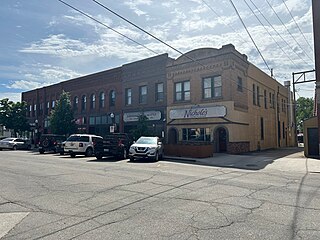
Fargo Station is a train station in Fargo, North Dakota, United States. It is served by Amtrak's Empire Builder. It is the only railway station in use in the Fargo-Moorhead area and is the third-busiest in North Dakota. The platform, tracks, and station are currently all owned by BNSF Railway. The station is currently located in the former BNSF freight house. The former main station building is now home to Great Northern Bicycle Co.

This is a list of the National Register of Historic Places listings in Cass County, North Dakota.

Barrington Apartments is a property in Fargo, North Dakota that was listed on the National Register of Historic Places in 1989.

Cass County Court House, Jail, and Sheriff's House is a property in Fargo, North Dakota that was listed on the National Register of Historic Places in 1983.
The Elliot–Powers House and Garage is a property in Fargo, North Dakota that was determined eligible for listing on the National Register of Historic Places on April 7, 1987, with reference number 87002634. It was not, however, actually listed, due to owner objection. Its listing status is "DO/Owner Objection".

Dibley House, also known as Graf House, is a property in Fargo, North Dakota that was listed on the National Register of Historic Places in 1980. The listing included two contributing buildings on an area of less than 1 acre (0.40 ha). The listing included two contributing buildings on an area of less than 1 acre (0.40 ha).

Downtown Fargo District, or Downtown Fargo Historic District, is a historic district in Fargo, North Dakota that was listed on the National Register of Historic Places in 1983.

The Fargo station is a former railway station in Fargo, North Dakota. Built in 1898, it was listed on the National Register of Historic Places in 1975 as the Northern Pacific Railway Depot.

Fargo City Detention Hospital is a building in Fargo, North Dakota, United States, that was built in 1910. The hospital was designed as a place to sequester people afflicted with contagious disease.

The Knerr Block, Floyd Block, McHench Building and Webster and Coe Building is a set of four buildings in Fargo, North Dakota that was listed on the National Register of Historic Places in 1983. The four buildings were built in 1900, 1902, and 1910. The oldest, the Webster and Coe building, was built in 1900 by a carpenter or contractor named Martel. The McHench Building was designed by the Hancock Brothers architects. The "four adjacent buildings constitute a solid front of excellent early turn-of-the-century commercial structures, displaying a continuity of fenestration and decorative brickwork."

The University of North Dakota Historic District is a 127-acre (51 ha) area in Grand Forks, North Dakota that was listed as a historic district in the National Register of Historic Places on January 13, 2010.
Fargo Bridge & Iron Co. was a bridge company based in North Dakota in the early part of the 20th century.
The Beaver Creek Bridge near Finley, North Dakota, also known as Newburgh Bridge, is a Pratt through truss bridge that was built in 1913. It is a pinned Pratt pony truss bridge and is "the oldest documented bridge in Steele County constructed by a long-term county bridge builder, the Fargo Bridge and Iron Company. Fargo built bridges in Steele County in almost every year between 1904 and 1920."
The Elliott Bridge, in North Dakota, United States, also known as Souris River Bridge, was built by Fargo Bridge & Iron Co. in 1902. The bridge "was designed to replace a county-owned ferry boat that had been operating across the Souris River at 'the Elliott Place.'" It was listed on the National Register of Historic Places in 1997. It is owned and maintained by McHenry County.

The North Side Fargo High Style Residential Historic District in Fargo, North Dakota has significance dating back to 1894. It is a 11.7-acre (4.7 ha) historic district with 33 contributing buildings. It includes Colonial Revival, American Foursquare, and other architecture. It was listed on the National Register of Historic Places in 1987.

The North Side Fargo Builder's Residential Historic District is a 25.4-acre (10.3 ha) historic district with 103 contributing buildings located eight blocks north of downtown Fargo, North Dakota. The district's name derives from the fact that the plans for the houses came from popular builder's pattern books. The homes were built in the late 1920s and 1930s. Tudor Revival is the predominant style, though Colonial Revival and American Foursquare architecture is also present. The district was listed on the National Register of Historic Places in 1987.
The Chesebro Smith House on Broadway in Fargo, North Dakota was built in 1909. It was listed on the National Register of Historic Places. But it was delisted from the Register in 2004.

The M.E. Beebe Historic District. in Fargo, North Dakota, is a .48 acres (0.19 ha) historic district which was listed on the National Register of Historic Places in 2015.

The George and Beth Anderson House is a Frank Lloyd Wright-esque style house in Fargo, North Dakota. It was listed on the National Register of Historic Places in 2017.

The Federal Building and U.S. Post Office at 657 2nd Ave. in Fargo, North Dakota, was built in 1969–70. It was listed on the National Register of Historic Places in 2021.


















